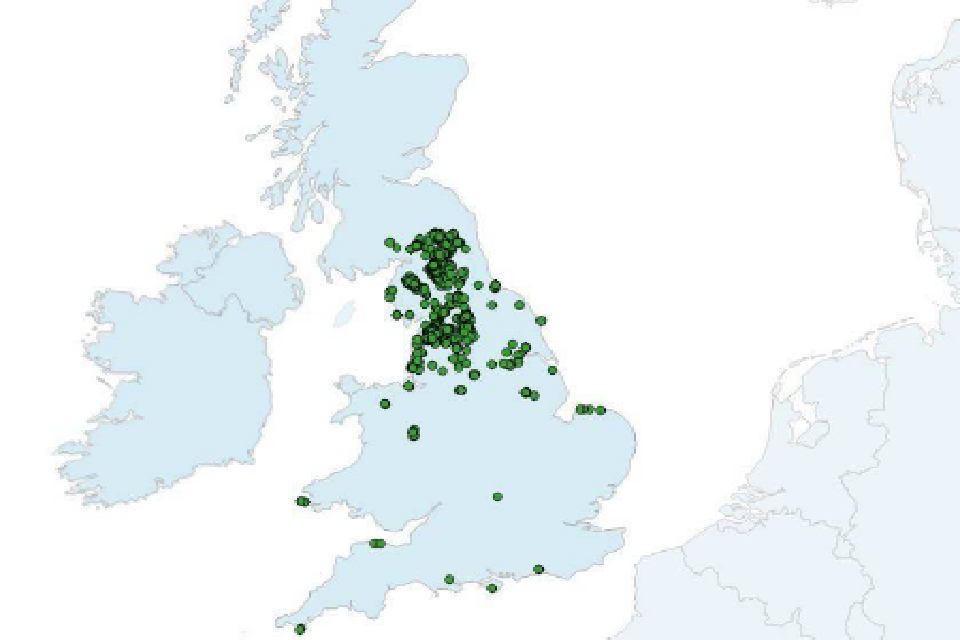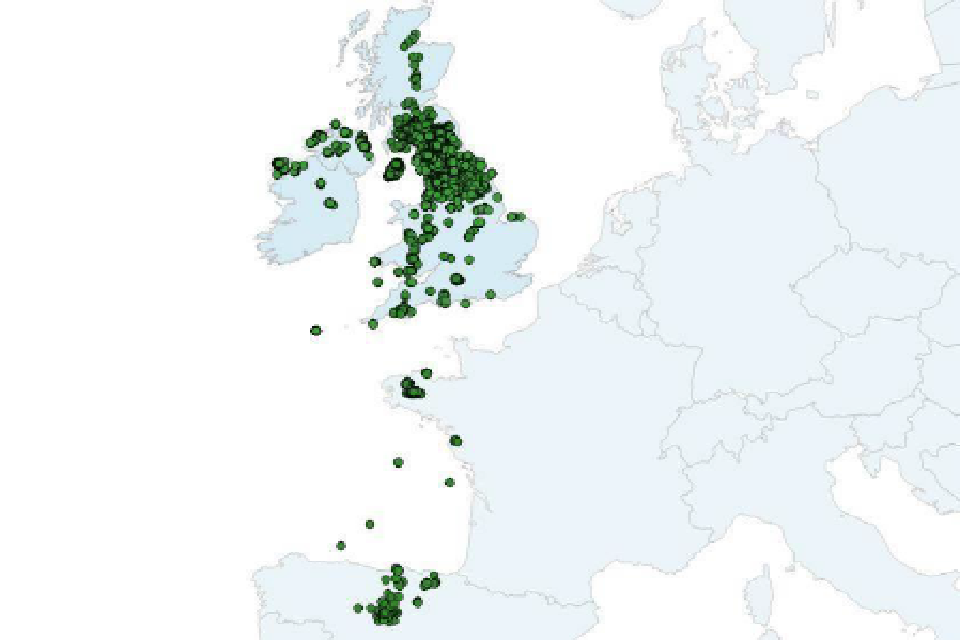Hen harrier tracking update: overview
Updated 3 October 2025
October 2025 update
The table of tagged hen harriers shows the status of satellite tagged birds as of October 2025.
April 2025 update
The table of tagged hen harriers shows the status of satellite tagged birds as of April 2025.
December 2024 update
The table of tagged hen harriers shows the status of satellite tagged birds as of December 2024.
August 2024 update
The table of tagged hen harriers shows the status of satellite tagged birds as of August 2024.
April 2024 update
The table of tagged hen harriers shows the status of satellite tagged birds as of April 2024.
December 2023 update
The table of tagged hen harriers shows the status of satellite tagged birds as of December 2023.
September 2023 update
The table of tagged hen harriers shows the status of satellite tagged birds as of September 2023.
May 2023 update
The table of tagged hen harriers shows the status of satellite tagged birds as of May 2023.
February 2023 update
The table of tagged hen harriers shows the status of satellite tagged birds as of February 2023.
August 2022 update
The table of tagged hen harriers shows the status changes of tagged birds since March 2022.
See Natural England’s blog for more information.
March 2022 update
The table of tagged hen harriers shows the status changes of tagged birds since November 2021.
See Natural England’s blog for more information.
November 2021 update
24 out of 31 pairs of hen harriers successfully bred in 2021 and 84 chicks fledged.
In 2021, Natural England followed 14 previously-tagged adult birds and tagged 17 chicks.
Four older adults attempted to breed in England, and one in Scotland. The remaining 9 adults were one-year-olds, of which 3 were wild-reared and 6 were from the 2020 brood-managed cohort.
Of the 17 tagged chicks:
- 10 were wild-reared birds
- 7 were brood-managed birds
The table of tagged hen harriers shows the status changes of tagged birds since July 2021.
See Natural England’s blog for more information.
July 2021 update
The table of tagged hen harriers shows the status changes of tagged birds since April 2021.
April 2021 update
The table of tagged hen harriers shows the status changes of tagged birds since January 2021.
January 2021 update
The table of tagged hen harriers shows the status changes of tagged birds since September 2020.
September 2020 update
60 hen harriers fledged in England in 2020. Natural England attached satellite tags to 23 of these birds.
The table of tagged hen harriers shows changes since the September 2019 update. It includes details of birds tagged in 2020 and those tagged earlier that are still alive or lost. Natural England updates the table every 3 months to show the status of each tagged bird and its approximate location.
November 2019 update
Natural England’s hen harrier programme deployed 2 types of satellite tag in 2019.
| Type of tag | Weight (g) | Number used in 2019 | Description | Deployed since | Accuracy |
|---|---|---|---|---|---|
| Microwave Telemetry Solar PTT 100 | 9.5 | 4 | Non-GPS devices that apply the Doppler effect to determine locations via the Argos satellite system. | 2007 | Highly reliable but location accuracy can be in a wide range. |
| Lotek PinPoint Solar Argos GPS | 6.8 | 8 | GPS-enabled tags that transmit data bundles to the Argos satellite system. | 2019 | New technology that provides significantly greater location accuracy. |
Both tags are solar powered and transmit on pre-set Argos duty cycles that include periods of hibernation to recharge the battery. Hen harriers are highly mobile and can travel several hundred miles during this downtime. The frequency of transmissions is dependent on battery voltage, which is influenced by:
- weather conditions
- feather coverage
- daylight availability
- latitude
- vegetation
Due to these restrictions neither tag model is completely predictable.
Technology is advancing each year. Natural England works closely with the manufacturers to refine tag design and improve performance. The satellite tags that Natural England deploys are not designed to be forensic tools. They are micro-weight tracking devices that help increase our knowledge of the hen harrier’s annual lifecycle.
The table of tagged hen harriers shows changes since the September 2019 update and the type of tag fitted to each bird.
September 2019 update
Forty-seven hen harriers fledged in England in 2019. Natural England attached satellite tags to 11 of these birds.
The table of tagged hen harriers shows changes since the January 2019 update. It includes details of birds tagged this summer and those tagged earlier that are still alive or been lost.
January 2019 update
Thirty-four hen harriers fledged in England in 2018. Natural England attached satellite tags to 5 of these birds.
The table of tagged hen harriers shows changes since the August 2018 update. It includes details of birds tagged last summer and those tagged earlier that are still alive or been lost.
August 2018 update
Natural England can now provide better detail on the location of the last known transmissions from tags fitted to hen harriers tracked by satellite.
On 25 August 2018, the Fitzpatrick Institute of African Ornithology, Aberdeen University and Natural England presented a paper of the data analysis at the International Ornithological Congress.
For transparency, Natural England is also publishing radio data collected between 2002 and 2008.
Species sensitivity
Natural England will not publish increased resolution data for 17 birds for the following reasons:
- to avoid attracting people to roost and nesting sites
- to reduce potential harm to the conservation of hen harriers at published locations
September 2017 update
For 15 years Natural England has tracked hen harriers to research their dispersal behaviour using a combination of radio and satellite devices.
The satellite tracking devices are lightweight transmitters. These are harnessed to the back of fledgling harriers. The devices can work for at least 3 years and locate any tagged bird to an accuracy of within 150 metres. This accuracy is dependent on the tag being able to recharge using solar energy at least every 48 hours.
Between 2002 and 2017 Natural England tracked 158 individual hen harriers of which:
- 6 were still alive in 2017
- 16 died of natural causes
- 3 were known to have been persecuted
The fate of the remaining 133 is unknown.
See the hen harrier combined tracking data sheet (updated September 2017).
Radio tracking data from 2002 to 2006
Early radio tracking technology recorded 99 birds. Figure 1 shows the location of birds from this data.

Figure 1. Wing tag sightings and radio tracking data 2002-2006
Observations were made from birds fitted with wing tags and radio tags. The limitation of this technology does not provide a complete picture of bird movement.
Satellite tracking data from 2007 to 2016
Figure 2 shows the movement of birds obtained from the satellite tracking data covering 59 birds.

Figure 2. Satellite tracking data from 2007 to 2016
Hen harrier dispersal from 2002 to 2016
Combined radio tracking and satellite tracking data shows the movement of hen harriers. Figure 3 shows movement of all the tracked birds across the UK and Europe.

Figure 3. Combined radio and satellite tracking data from 2002 to 2016
More information
Read more about the initial findings from the hen harrier tracking programme 2007 to 2014.

